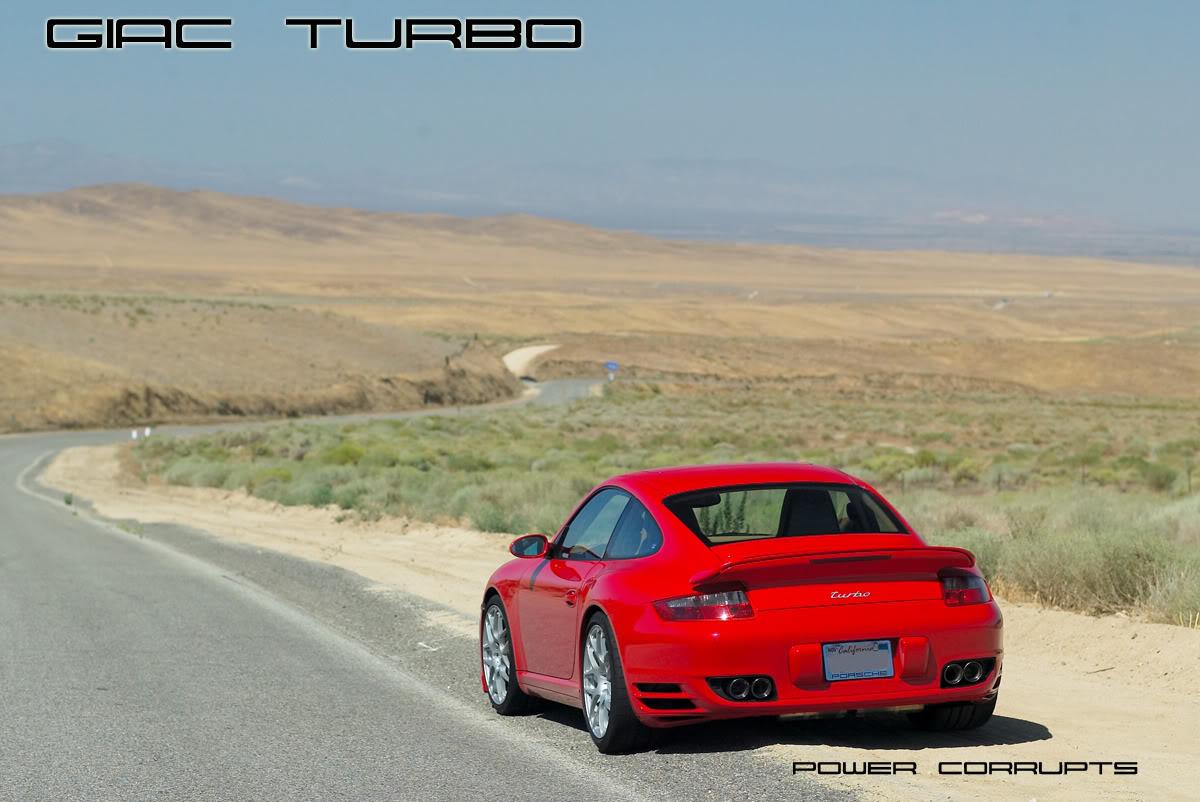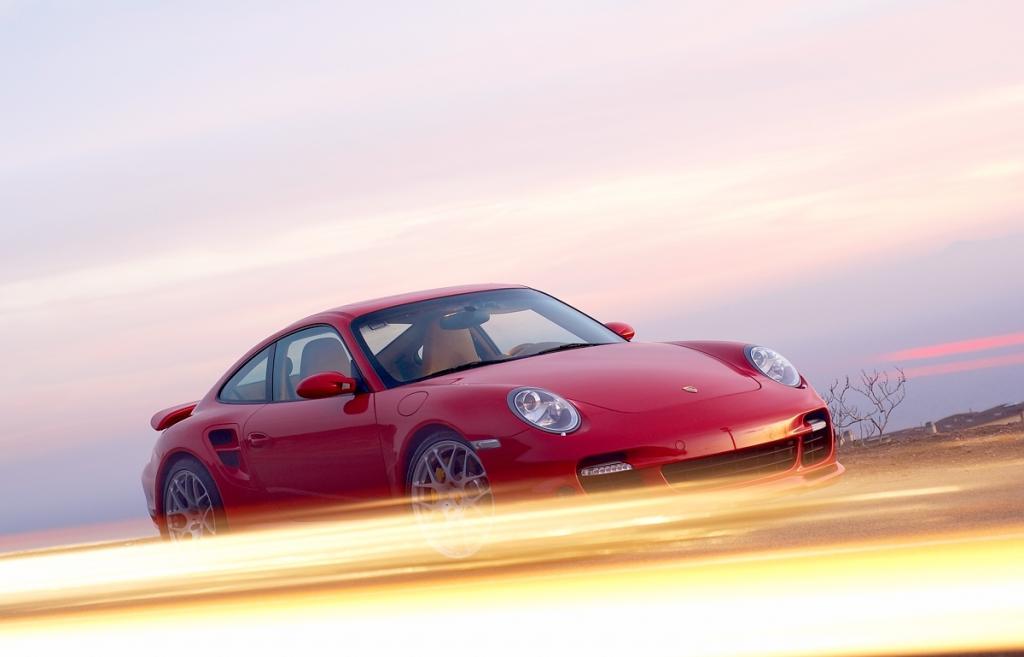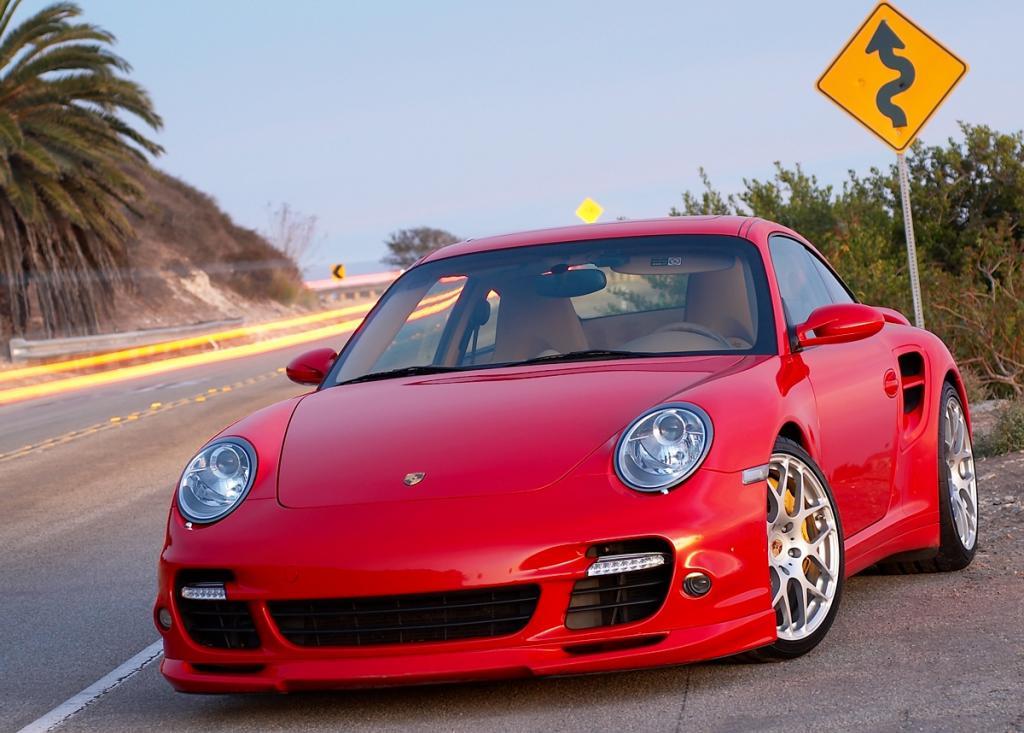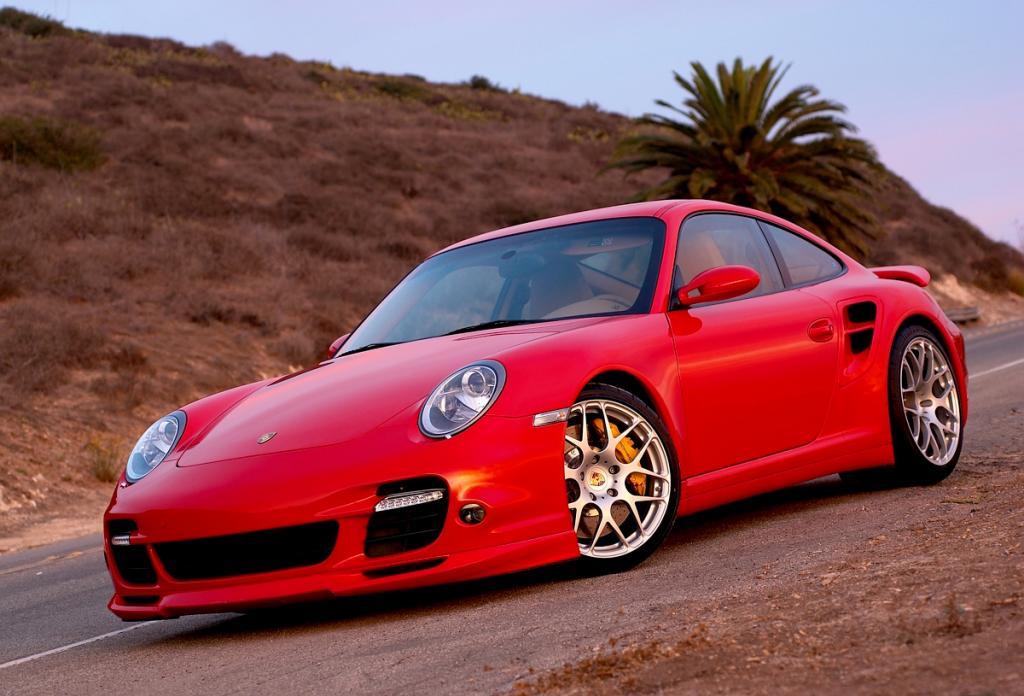You must be logged in to rate content!
29 minute(s) of a 612 minute read
7-3-2008
Pics & Review of My Bilstein PSS10 Lowered Red Turbo
Compliments of cannga @ www.6speedonline.com
7-3-2008
I. Index of important posts on this long thread:
OVERVIEW: Where to start, what to change, why, how, etc. Post #4 below
997.1 vs 997.2 Suspension #168 Here
Coilover vs. Lowering Springs #168 Here
Ride Height Measurement: #187 Here
Spring Rates Summary of Various Suspension Systems #168 Here
Spring Replacements & How to turn your Turbo into a GT3 ;-) #242 Here
Sway Bar - All You Need To Know # 72 Here
Tire Review, Discussion, and Weights: #286 & 287 Here
Tire Pressure: #240 Here
Understeer/Oversteer Summary Table #80 #179 Here
Installation with Great Instruction & Pictures by Gary Here
Which lowering springs to use? #541 Here
II. What is Bilstein B16 Damptronic?
When Porsche 997 Turbo was released in 2007, it wasn't long before enthusiasts noticed its very soft suspension. While Porsche suspension engineers are obviously among the very best in the world, they deliberately de-tuned the Turbo to be a Grand Tourer, and as result the car has a soft suspension with a lot of body lean in high speed corners, a lot of squatting and diving with accel and decel, and lazy/sloppy steering. These characteristics are devastating to me and unheard of for a Porsche. Secondly, the stock suspension has major problem with first gen PASM - Normal setting is way too soft, while Sport completely stiff and jittery, very much one extreme or another, with nothing in between. (First gen. PASM was a design flaw and indeed Porsche made significant revision to PASM gen 2.) The 997 Turbo was fast for sure, but its ponderous handling felt out of place in a car that's supposed to be among the world's best. GT3 owners speak of Turbo handling with disdain. Professional reviewers tend to label it "fast but numb and soulless" (ouch!).
Fortunately, the same company that makes OEM suspension for Porsche 911, Bilstein, in 2008 released the Bilstein B16 Damptronic: a street/track combo coilover setup designed by the same company, engineers, and Porsche test driver as the stock OEM system (Walter Rohrl is a Bilstein consultant). The Bilstein upon release immediately became a no-brainer recommendationbecause it is in essence a mod made by Porsche itself. To many enthusiasts, this is how the Porsche Turbo should have been released in the first place.
Subsequently, the Bilstein B16 Damptronic went on to become by far the most popular coilover mod for Porsche Turbo, based on my extensive web research :-). That comes probably as no surprise because of A. what it does: it totally transforms the stock car from a soft grand tourer to a legitimate world class sports car, and B. what it costs: economy of scale from Bilstein itself, and C. what Bilstein offers: lifetime warranty (incredible if you think about it). With respect to reliability, while nothing is perfect - sh*t happens with mods and anyone should be smart enough to know that by now, Bilstein's reliability is as good as any suspension setup, if not among best in industry. To me, there are enough data now to indicate an overwhelming majority of suspension setup problems is from poor installation (Even pro's make mistake - over torquing, forget washer, etc., and be smart when they tell you "we did nothing wrong", what else do you expect them to say?), too much lowering, and adding other stiff components/links to the car that the suspension was never designed with. Bottom line: always, always, always get the most experienced tech to install you suspension, don't lower the car too much, buy only from authorized dealer (lifetime warranty), and be careful with "other components" added to suspension. An excellent and reputable dealer for Bilstein with excellent pricing is AWE Tuning: http://www.awe-tuning.com/bilstein-b...onic-49-135985 (There are two versions of B16 Damptronic, a "Sport" version and a "Comfort" version http://cart.bilsteinus.com/search/mmid=204047/drivetype=AWD. Based strictly on my taste and personal preference, I would recommend that you get the Sport version, which is 49-135985, and NOT the Comfort version, which is 49-135817.)
For those new to suspension tuning, do not be afraid of changing stock suspension if you think the car is too soft. Suspension tuning is always a trade-off between ride and handling; there is no right or wrong. Porsche Turbo's stock suspension is merely Porsche's "vision" of what would please most people for a grand tourer and sell the most cars. IOW, it is a compromise - why it is so much more ponderous than GT3, and the Porsche suspension is easily modified for the implied reason: you should change it if it doesn't fit you. Join the club and a whole new world of sharp and tight handling and steering will be open to you - I guarantee. :-)
While there are alternatives such as KW, Moton, JRZ, remember that these systems are more for the track (stiff), you lose PASM, and the damping forces have to be adjusted manually. The KW V3 also has what seems to be front end that is too soft causing the car to dive with braking as per reports (no direct experience, search here on this forum FYI). Damping force adjustment is not a simple matter as some vendors make it out to be (adjust so and so for comfort, so and so for handling ---> bad simplification IMHO): when you adjust for comfort, handling is affected adversely; as importantly understeer/oversteer behavior will be changed as well. For this reason IMHO Bilstein is still the first and only choice for a mostly street car; there are other excellent coilovers but many are designed for the track and people have had problems with stiffness for street use. (BTW, KW V3 is an excellent coilover but I am currently withholding recommendation because there is something odd about its spring rates, resulting in a car that's soft in front and very stiff in rear that a few owners have complained about.)
What is PASM? This means electronic and automatic adjustment of the damping force and you don't have to set damping force. The Bilstein Damptronic is the only system in the market that maintains PASM of the stock system. It acts just like the stock system and has 2 modes, but here the 2 modes are closer to each other in feel and very useable, not way too soft (Normal) or way too hard (Hard) like the stock system. This alone is worth the change as now both modes are useable. There are 2 Bilstein versions: B16 Damptronic with PASM (automatic damping adjustment) and B16 PSS10 without PASM (manual damping adjustment like Moton/JRZ/etc.). If you worry about PASM electronic system giving you problems, then get the PSS10 (NOT Damptronic) version. My vote remains with the popular Bilstein Damptronic because simply I am having an absolute blast and a grin on my face every day.![]() Kidding aside, a popular, well proven, automatic turn-key solution essentially made by Porsche - what more could you ask for?
Kidding aside, a popular, well proven, automatic turn-key solution essentially made by Porsche - what more could you ask for?
III. A summary of what's been done to the car by Tom of Lucent Motors, Los Angeles (cell # 310-733-7324) in June 16, 2008. Lucent is a small Porsche shop with great reputation among Porsche "nuts." Tom will take time to discuss risks/benefits of each mod with you. He is a fantastic tech/mechanic & I am thankful he has worked on my car. Yes this means the highest recommendation and no, this doesn't mean I am responsible for your choice of which tuner to use, Lucent included. I have nothing (business/personal) to do with any of the multiple shops and products I recommend on this thread and I'm only reporting my experience. If you choose any of them, remember shiit happens when you mod, no one made you do it, take responsibility for this choice and don't whine ;-) to me if something is not to your liking pls.
1. Hardware: Bilstein B16 Damptronic & GMG Anti-sway Bar with rear Tarett drop links. The GMG bar is set at full soft front and medium rear, using Tarett drop links (stiffer, more precise, more planted than the rubber links). Ride height drops are about 12mm front, 12mm rear (stock turbo 132 front/153 rear, mine 120/141, GT2 110/147). In the past I've lowered the car 22mm front/12mm rear. In a correct installation, height change does NOT alter stiffness, but I don't like to lower more than 10-12 mm for a different reason: I don't like to alter too much the 3D geometric relationship of the various suspension components.
2. Alignment Change - more front neg. camber, now at minus 1.1 degree (stock is minus 0.6) and slight toe out in front for faster, less lazy steering. These changes are as important as hardware change; don't forget them. Print my alignment diagram below and give it to your tuner.
3. Tire: Currently Michelin Pilot Super Sport. In the past I used R comp tire, Pirelli Corsa, which has stunning traction and handles well because of stiffer sidewall, but very noisy and uncomfortable in the long run.
This simple combination brings my Turbo to what I consider to be the epitome of a sporty daily driver: firm but still comfortable, much more precise and tighter than stock especially the rear, corners as if on rails with very little body lean, yet the suspension is still compliant. I test drive many different sports cars (Ferrari F430 & California, Lambo, Corvette, other Porsche's, etc.) and the more I test other cars, the more I love my Turbo baby. Yes it is that fantastic.
IV. Finally, the original review:
Warning: If the Turbo suspension feels perfect to you, stop reading now.![]() My "dissertation" is subjective in nature and might be upsetting. For me, one troubling thing about the Turbo is that besides the tremendous power and torque, over the long run, it’s not a fun car to drive. The handling is a tad sloppy, IMO a result of the soft spring rates and the enigmatic PASM system. The steering is good but feels inferior to my 997 C2 in feel and feedback. My suspicion was confirmed after a test drive in the GT2: Porsche has elected to make the Turbo too much of a luxurious grand touring car. My baby feels like a Mercedes after a 35 mile drive in that incredible GT2; no kidding.
My "dissertation" is subjective in nature and might be upsetting. For me, one troubling thing about the Turbo is that besides the tremendous power and torque, over the long run, it’s not a fun car to drive. The handling is a tad sloppy, IMO a result of the soft spring rates and the enigmatic PASM system. The steering is good but feels inferior to my 997 C2 in feel and feedback. My suspicion was confirmed after a test drive in the GT2: Porsche has elected to make the Turbo too much of a luxurious grand touring car. My baby feels like a Mercedes after a 35 mile drive in that incredible GT2; no kidding.
What I've done to my car so far:
1. Bilstein PSS10 with a height drop of approx. 10 mm.
2. Street GT3 alignment, meaning a change of front camber from -.4 to -1.2.
3. GMG anti-sway bar; set to full soft front, medium stiff rear.
These are common and fairly conservative changes so I am not blazing a trail here. You are basically buying Bilstein’s vision of what a mostly street-use Turbo should feel like. Consider what they do for a living, this is not a bad place to start. Technically, with its mono-tube dampener and dual spring setup, the Bilstein PSS10 is an advanced design.
While the effect of the sway bar is subtle, the PSS10 brings significant and easily noticeable changes. Some of these changes were expected—the Bilstein is no doubt geared more towards performance and its spring rates AFAIK are close to those of the GT2/GT3 class Porsche, others came as a surprise.
Handling:
While the stock Turbo could take simple corners with tremendous speed (as long as slow-in-fast-out is observed), when faced with combination curves, for example a fast S-shaped left-right combination, it staggers like a drunkard.
That the rear of the car likes to “walk” laterally while cornering is not that big of a surprise; after all, the engine is hanging out back there. The problem I have is that there are considerable vertical motions as well. In fast & bumpy corners, the rear has a mind of its own, and that mind belongs to a mambo dancer.
The Bilstein PSS10 and minor alignment change have completely transformed the Turbo’s behavior. The suspension feels taut. Rear end motion is now 1000% better. In corners, problem with the stock car’s tendency to understeer has markedly improved. Please trust me on this (grin)--I used to be skeptical too, the turn-in in corners feels different and better. Above all, it is now fun to take twisty roads with this car.
There is no more excessive front to back weight transfer with acceleration (squatting), and no more excessive side to side leaning in corners. It feels WONDERFUL.
Steering:
Before the suspension change, if I roll the steering wheel gently back and forth at say 70 mph, there would be some undesirable free play, or lag, to the car’s response. After the steering wheel is turned, the car would take a split nanosecond before it changes direction, then it continues to lean a little bit after I’ve stopped moving the steering wheel. In addition, the steering is *too* comfortable in a curve: soft, even flabby maybe, with less feedback than I would like.
I do not know which of the 2 mods, alignment change versus Bilstein PSS10, is responsible, as unfortunately my planning didn’t pan out and both those changes were done at the same time, but the steering response is now sharp and much more instantaneous. The feel is tight, and feedback during turns is outstanding.
Subjective/Objective Power Increase
The modded Turbo for whatever reason feels quicker & I don’t have the need to always turn on Sport Mode like I used too. My speculation for this observation, 2 reasons: Since the car doesn’t squat as much when throttle is opened, one, traction of front wheels is maintained for more power delivery, and, two, perhaps more power of that first instance of acceleration is going to the wheel, instead of being wasted in lifting the front of the chassis. Or it could be entirely in my head.
Whether this observation is subjective or objective in nature, bottom line is the effect is easily noticeable. Plainly and simply the car’s acceleration when you step on the gas "arrives" quicker, with less lag. This then is the biggest and most pleasant surprise of this suspension mod.
Since there is less diving under braking, I would imagine that braking is also more efficient since the rear wheels are now stay put instead of lifting, but I do not feel this at my amateur level of pre-corner braking.
Rough Road Management & Noise:
Bilstein can't perform a miracle; you will sense more road bumps. However, the feel is vastly superior to the jittery ride of PASM-Firm and is entirely acceptable for my daily 35 miles drive to or from work in ?xml:namespace prefix = st1 /?xml:namespace prefix = st1 /?xml:namespace prefix = st1 /?xml:namespace prefix = st1 /?xml:namespace prefix = st1 /?xml:namespace prefix = st1 /?xml:namespace prefix = st1 /?xml:namespace prefix = st1 /?xml:namespace prefix = st1 /?xml:namespace prefix = st1 /?xml:namespace prefix = st1 /?xml:namespace prefix = st1 /?xml:namespace prefix = st1 /?xml:namespace prefix = st1 /?xml:namespace prefix = st1 /?xml:namespace prefix = st1 /Los Angeles. Road bumps create a more compliant feel & conventional thump sound (yes I am the type of person who listens to my car’s suspension--LOL), versus PASM-Firm’s choppy and somehow unnatural feel, and the louder noise when the car hits things like freeway’s expansion joints. For comfort level, if PASM-Normal is 10 out of 10, then Bilstein would be a 6 to 7, and PASM-Firm 1, tied with a Sherman M4.
There is also more road noise transmitted to the cabin, and for whatever reason, the exhaust noise sounds louder. Perhaps the smaller space underneath the car (from the lower ride height) creates some boom box effect.
With the above suspension mods, IMHO the Turbo could now more seriously compete with the GT2, if not in tracking prowess (AWD & Turbo weighs too much), then in FUN FACTOR. The GT2 is an all-out track car with a “heavy machinery” feel to it—heavy clutch, heavy gear shift, heavy (but fantastic) steering feel. The modded Turbo has advantages & disadvantages inherent to its AWD system, and despite of its avoir-du-pois problem, feels surprisingly agile & light footed. For my amateur skill and speed level, cornering behavior is now similar between the two.
My Turbo baby used to feel ponderous and soft, now it feels tighter, cat-quick, and lots and lots and lots of fun. Steering and suspension feedbacks are significantly improved over stock, and of course, that nuclear power plant that disguises as the engine is as stupendous as ever. I am grinning from ear to ear every time I come close to this car. The grin-score is so much higher that I would give the Bilstein an unqualified recommendation and rank its usefulness higher than PCCB brake, power mod, exhaust system change, and after-market wheels. For me the Bilstein PSS10 is an ***ABSOLUTE MUST*** if attributes that make a sport car feel sporty are important to you.
If you are new to alignment settings and don't know what to do,print the following chart and give it to your tuner: What you are doing is increase your negative front camber to minus 1.2. More front negative camber is crucial as it reduces understeer and improves front cornering force. I think you will love the change.
For the more advanced driver, you could also add a slight front toe out as seen in the diagram. This makes steering very quick (I love it because the stock Turbo's steering feels lazy.) and so is turn-in response. Quick and light.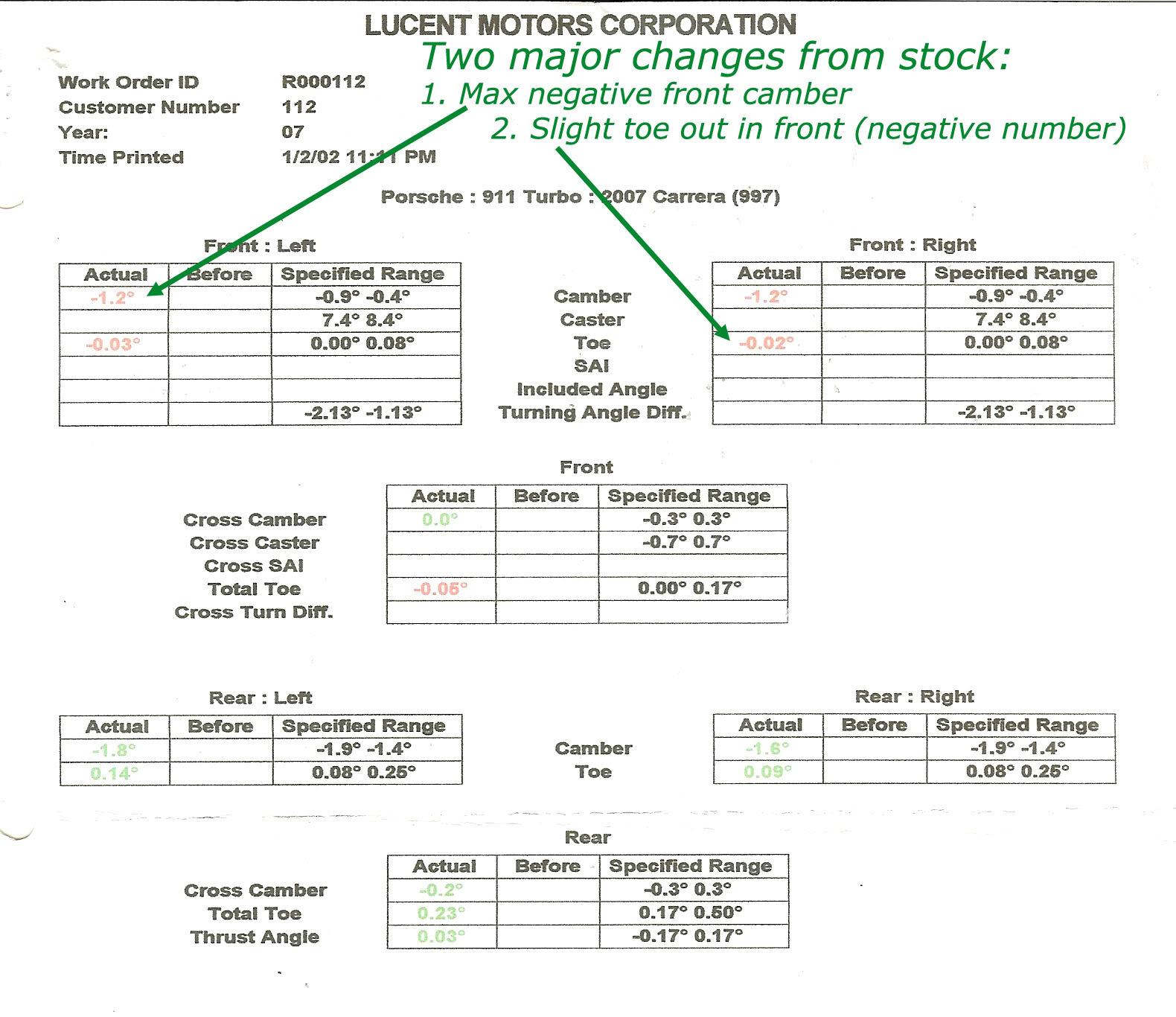
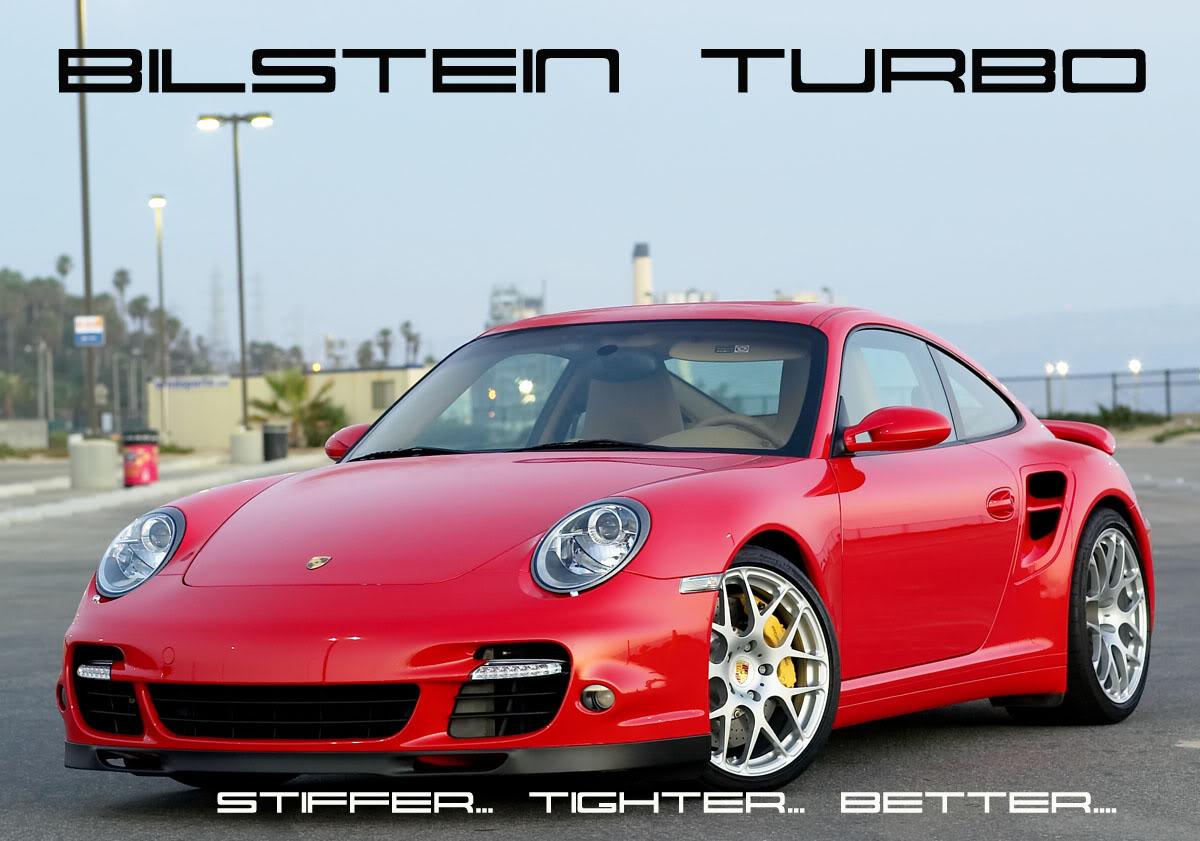
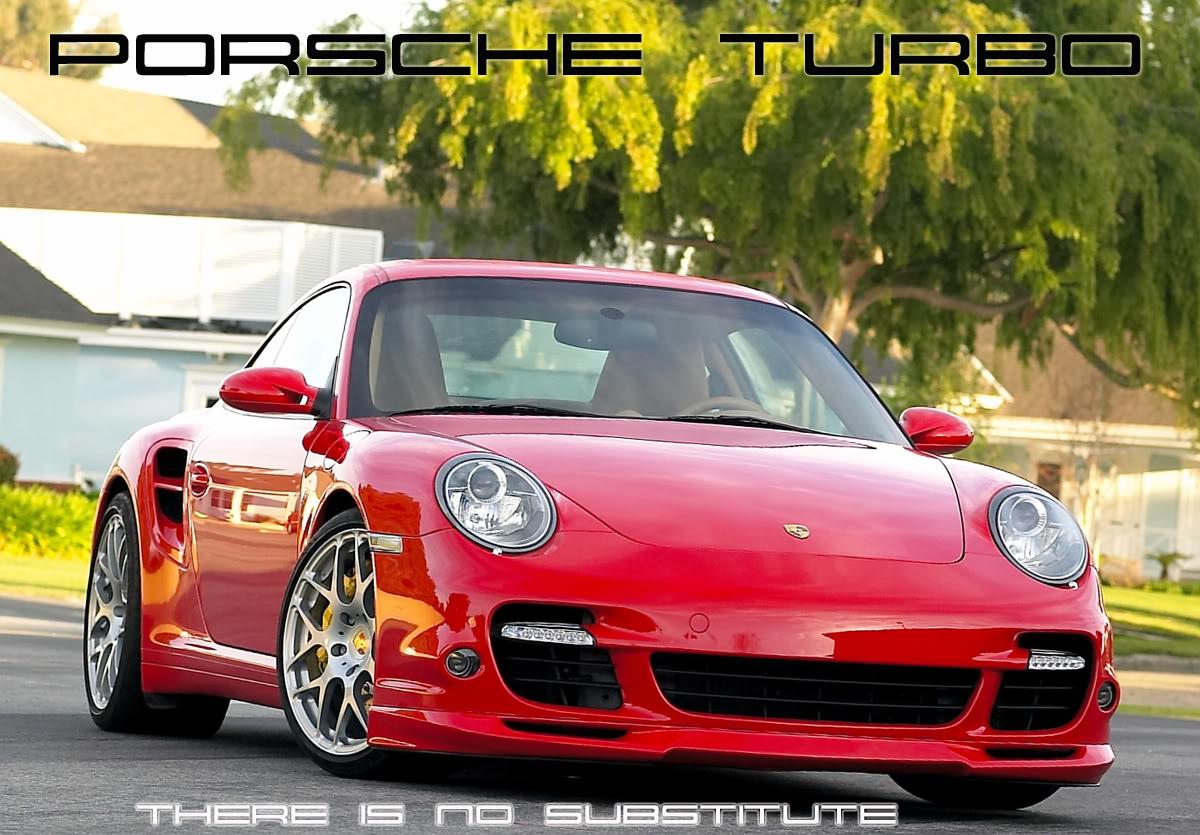
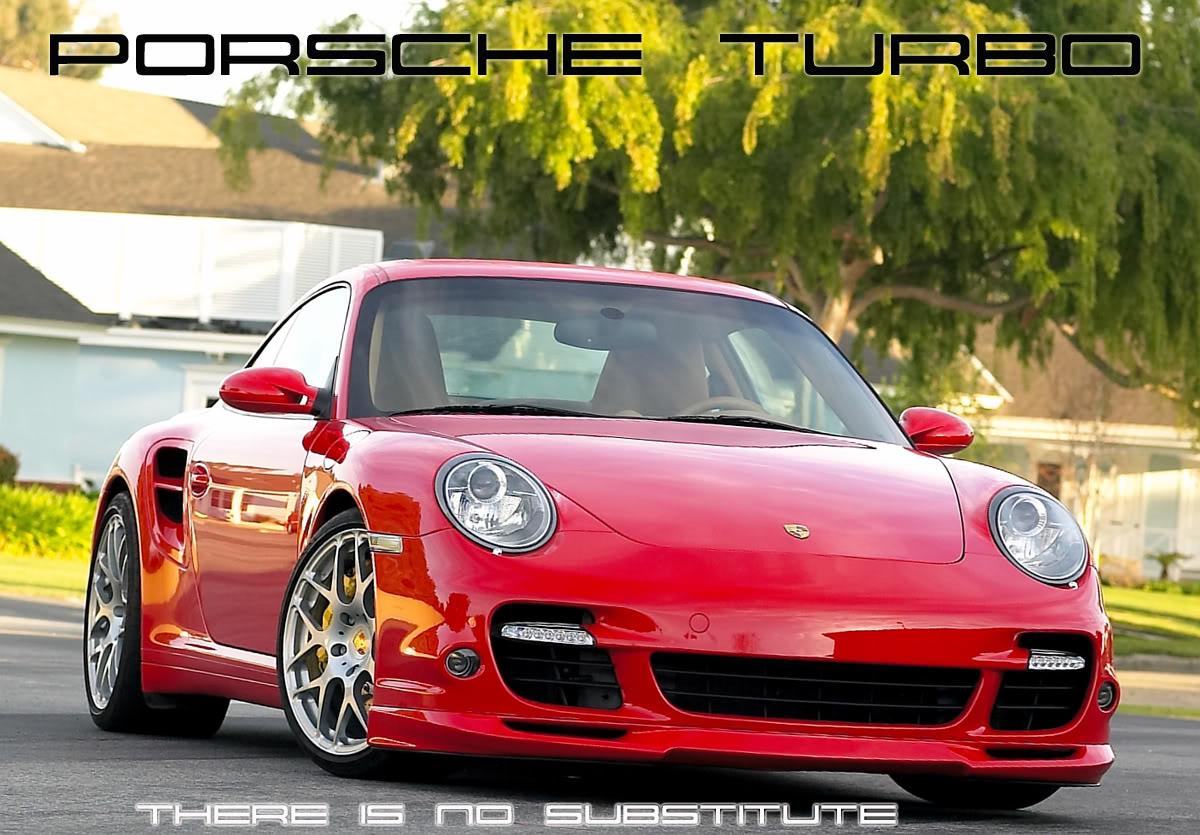
Hope this helps those completely new to this. Anyone please add/correct me as needed. I will edit as necessary.
Suspension Mods Overview:
Suspension mod is easier to understand if you categorize the modifications. Then all of sudden, things will seem so simple ;-) and not so intimidating. I will arbitrarily create 4 categories:
1. Stiffer suspension - springs or coilover: this is the single most important mod in the Turbo and will transform the car. It is accomplished by using lowering springs (I prefer coilover but lowering springs are simpler, less costly, and also work well) or using coilover (springs + damper, aka shock absorber) such as those made by Bilstein or KW/JRZ/Moton/etc. Positives: Stiffer and lower are almost always better in a sports car: less weight transfer (lower), less body roll (sitffer), less dive and squat, more precise response. Negatives: Ride versus handling trade-off is forever present - the law of physics. As handling improves, ride will suffer. For street driving, don't use Moton or JRZ because they are too stiff, KW is also on stiff side.
Damper/PASM modifier (TPC's DSC): The second, less desirable way to stiffen the suspension is by stiffening the damper. How? 997.1 Turbo introduces damper that could change damping force electronically. This is done by electronic PASM program that control the opening and closing of the damper's internal valves. Sounds great except that the 997.1 PASM program is not very good: the normal mode is way too soft and the sport mode is way too stiff. TPC Racing DSC module modifies this electronic program, essentially change the bump and rebound settings, and is an excellent product; easy to install and in general very well reviewed by users. However, it is NOT a magic does-it-all solution: it has limitations, chief among which is that it simply works with damper adjustment on the not-very-good soft stock damper, and that it does not lower the car like lowering spring or coilover would (very important to improve handling). TPC itself recommends coilover for more "serious" suspension mod. In addition, if you are going to use coilover such as Bilstein, then you do not "need" the TPC DSC. In general, I do not believe in adjusting damping force solely to control handling, and would vote to use lowering springs and coilover as the first step. The TPC DSC is a great solution only if you are looking for a more simple, easy to do mod. If you want to see nirvana in handling, you will need to do more.
2. Alignment: involves toe, caster, camber. For all practical purposes, all you need to worry about in the Turbo is to increase front negative camber. Stock is around -0.8, you want to increase this to -1.2 or so (the max possible). Positives: Negative camber increases cornering force/traction of the tire (allows you to corner faster), decreases understeer which is an inherent problem with AWD 997.1 Turbo (complicated, pls just trust me this is the case). Negatives: Excessive & uneven tire wear and straight-line traction/acceleration could be affected adversely if over-done.
3. Stiffer "other" components: This would fall into 2 categories:
A. Sway bar: used to fine tune the system, in particular the understeer/oversteer behavior. After market sway bars are not only stiffer, they have adjustable stiffness. In the AWD Turbo with inherent understeer trait, the recommended setting is soft front, stiff rear, to decrease understeer. Note that sway bar on stiff setting could have major effect on the comfort of your ride (very un-comfortable). Positives: Decrease body roll, adjust understeer/oversteer, stiffer front sway bar makes steering firmer and feel more precise. Negatives: Decreases ride comfort.
B. After market suspension links that use solid metallic bushing/joint, in place of stock rubber/neoprene bushing/joint. The links include rear upper links (dog bones), toe control link, thrust arm bushing, front camber plate, drop links, etc. Positives: Solid links increase precision and make cars feel more "planted"/precise. Negatives: Increase noise, vibration, harshness, some more than others. Also, these are wear-and-tear items and need to be checked periodically and replaced when the joints become loose (metallic joints/links don't last as long as rubber/neoprene joints/links).
4. Tires: Don't under-estimate this major component of suspension system, and never race another car that has superior tires! This means street tires such as Michelin PSS for street cars are ok, but for the track and for racing, you must have at least higher traction and stiffer side-wall R compound tires such as Michelin Cup or Pirelli Corsa. Positives: have inherent advantages of stickier rubber, stiffer wall. Negatives: Dangerous on wet roads (no wet traction, aqua-plane), takes time to warm up, noisy & stiff especially when old.
My Suggestion of Stages to Upgrade Your Car's Suspension: First please keep in mind the following rambling :-) of suspension "stages" is merely my opinions, although ones that are based on a lot of experimenting, reading, and questioning of professional tuners. It is a very generalized guideline so relax, and don't nit pick :-). I assume before going further, the first question to ask is WHAT are we trying to accomplish when we mod the suspension? To answer this question is to understand the hundreds of posts that follow. The answer is, in general, we mod the suspension to:
A. reduce body roll/weight transfer (not the same thing, but long story and will not cover here)
B. increase grip in corners.
It is because of A and B above that you will notice that *in general* nearly everything we do goes towards stiffening and lowering the car, and increasing tire contact in corners.
Stage 1.
***Coilover or lowering springs: I prefer coilover but if cost is a problem, stiff lowering springs like Eibach, GMG (made by Eibach), or Techart are good alternatives. Keep in mind people move/upgrade from lowering springs to coilover, never the other way around so going w/ springs might cost more in the long run. For coilover, I recommend Bilstein Damptronic (with PASM) as a perfect street/occasional track car, and Bilstein PSS10 (no PASM) if you worry about PASM's reliability. For a track car only, then there are other choices such as JRZ, Ohlins, etc.
***After-market sway bar: Set front softer than rear, to counter our 4WD cars' tendency to understeer. I have GMG but there are a few good ones on the market: Eibach, H&R, TPC, etc. GMG is only company that publishes specs on their sway and that's why I prefer it.
***Alignment change: Increase front camber to its max value, around minus 1.2. The simplest and cheapest mod to our Turbo; recommended without reservation. This is also known as the GT3's street setting and you WILL feel the difference in corners from the higher front end traction. Also decreases understeer, an inherent "problem" with our 4WD 997 Turbo.
Stage 2.
***Drop links with heim joint: Heim joint is metallic, as opposed to stock rubber bushing. After-market drop links like those from Tarett Engineering (well known, reputable, and cheapest) are stiffer and make car feel less rubbery and much more planted. It also reduces a lot of lateral and vertical motion of the Turbo's rear wheel under acceleration. This is among the most cost effective of all suspenson mods and I cannot recommend it highly enough: cheap, adjustable by yourself at home. It's also totally reversible so if you don't like it, just take it out. And why wouldn't you like it? It makes the ride stiffer and road noise louder; as always, suspension tuning is about trade-off. Click Here to See Rear Tarett Drop Link . I have this on versus off every few months, sometimes just to study the behavior of the car.
Stage 3. For those who want more precision, tightness, and thrill, and willing to sacrifice some noise and comfort.
***Rear toe control arm (see picture with labels below) Now we are starting to get serious: you are modifying the link of the suspension itself. This means more expertise needed in installation *and* more maintenance in the long run. Of all the links, this is probably the single most universally recommended component. I might try it one of these days, but I am so happy with my car now that I am not touching it!
***R comp tires if it doesn't rain too much where you live and you don't mind the noise and stiffness. A must-try once in your life if you are serious about motorsports, but remember they are extremely dangerous in the rain.
***Change to Stiffer Spring Rates: After all, this is what the coilover is designed for, to change your spring rates to taste. For those of us who want GT3's handling in our Turbo.
Stage 4.
Now we are definitely into "advanced driver" territory, for the track junkies among us - you might want to go to rennlist GT3 forum for more info there. Some of the stuffs people use that I don't plan to try because my car is a daily driver:
***Front Camber Plate: Only use this if you want more than minus 1 camber in front; I don't have it in my car because I don't track it. Large front negative camber is more for the extreme high cornering speed at the track, but there *is* a cost: you lose straight line traction and braking power. Click Here to See What They Are.
***Rear Upper Control Arm (dog bones), etc., etc. Just remember the Pluses and Minuses of all these links that replace rubber with metal: Positives: Solid links increase precision and make cars feel more "planted"/precise. Negatives: Increase noise, vibration, harshness, some more than others. Also, these are wear-and-tear items and need to be checked periodically and replaced when the joints become loose (metallic joints/links don't last as long as rubber/neoprene joints/links).
***Front and rear Lower Control Arm: Primarily for the track junkies who must have higher negative camber than what stock offers (stock maxes out at -1.2 front).
Some Do's and Don'ts of suspension modification:
1. Do not let any rookie technician touch your car. The most important factor in suspension modification: A competent AND experienced installer. Using an inexperienced tech could be devastating and dangerous as we've seen broken coilover with wrong installation, etc. I am now more convinced than ever that a significant number of suspension problems (noise, links become loose, etc.) are related to installation error. This includes missing components, components put in backward, lowering the car too much, etc. BTW, I also believe that the more you lower the car beyond 10mm, the more likely is the chance that things will go wrong in the future, like broken drop links. This is because you've changed too much the 3D geometry relationship of the various link connections.
2. Do not buy used suspension components. Suspension is among THE most important component of the car so this is not the time or place to be cheap and save money guys. Buy new and buy from authorized dealer (you could still get discount from authorized dealer such as AWE Tuning). It's an absolute nightmare when something doesn't work as you have no warranty and the labor cost of removing, checking, re-installing becomes quite significant. Parts may be missing - an outright dangerous situation, things may be broken during removal. I know it's tempting, just DO NOT. This is a 120,000 car, don't try to save $ on this critical component!
3. Try to mod one component at a time. I know, the temptation to keep things simple and save installation money: install the whole 4 stages of suspension mod all at once. I understand completely but in general still advise that you mod suspension in multiple stages. This makes the process extremely educational and fun. In addition, if something goes wrong, or something is not to your liking, you'll know exactly which and who is responsible for the problem. The mod operanda for suspension component mod and adjustment: One part, one axle at a time.
4. Sometimes, sh*t happens when you mod your car. I've seen problems with the most reliable of components, with ECU tune, with exhaust; I've seen problems with lowering springs; I've seen problems with Moton, KW, Bilstein (99% installation-error related). These are wear items and mods definitely are not reliable as stock (exhaust gives CEL, ECU mod blows up engines, suspension mods squeak, bluetooth mod never works right, etc., etc.) so don't do this if you are the type who expect forever perfection, 100% of times - STAY with stock suspension. Things do wear and break, even stock car does, and I do advocate that you only buy new Bilstein from authorized dealer and to keep your record. A couple of people on this board bought stuffs from un-authorized dealer and even used suspension components and got burned as a result - don't do this. One guy had a tire store adjust his suspension component - don't do this.
When problems occur, KNOW that it would involve taking out the suspension and send to Bilstein for repair or replacement - NOT a simple process. Bilstein has an extremely generous life time warranty but unfortunately do require that you send back the components for inspection for abuse. It is not an easy process and it's therefore a good idea to hold on to your stock suspension pieces even if you don't think you'll ever use it again. You have been forewarned so please remember: no one made you do it, take responsibility for your decision to mod, and don't whine to me if something is not to your liking. ![]() . "Weird" problems are part of the modding game. Know this before you proceed.
. "Weird" problems are part of the modding game. Know this before you proceed.
Thanks for the nice comments. A couple more shots, after lowering; 1st picture in switchback behind my house (Southern Cal), second shot in Antelope Valley Poppy Field Reserve:
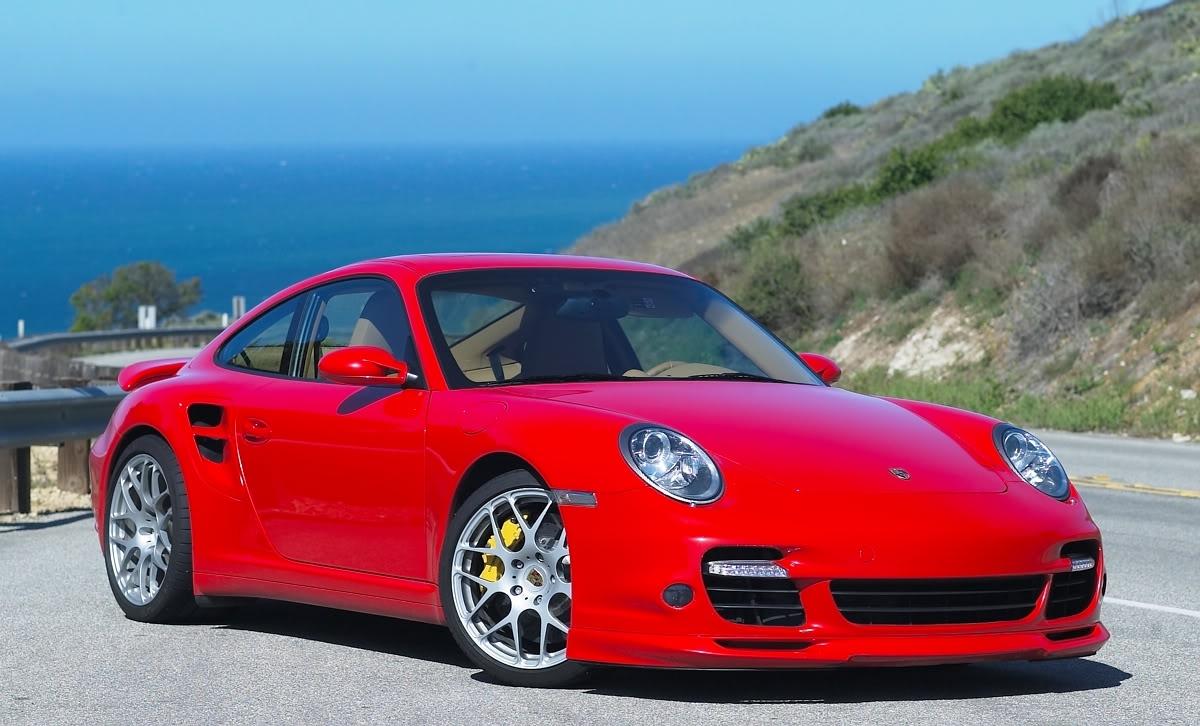
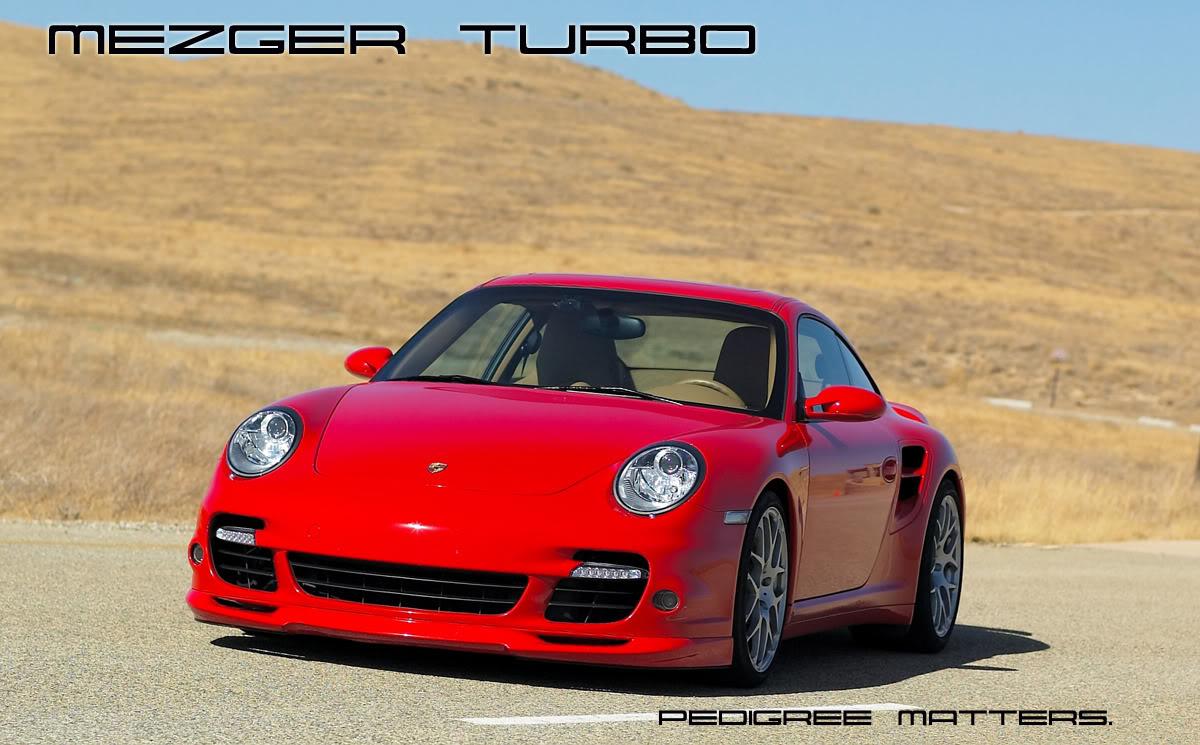
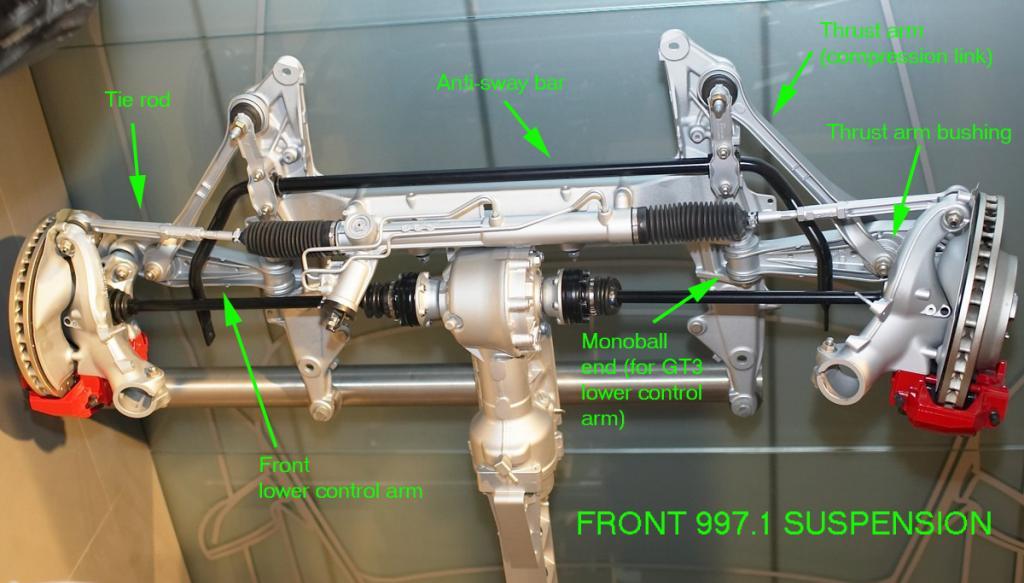
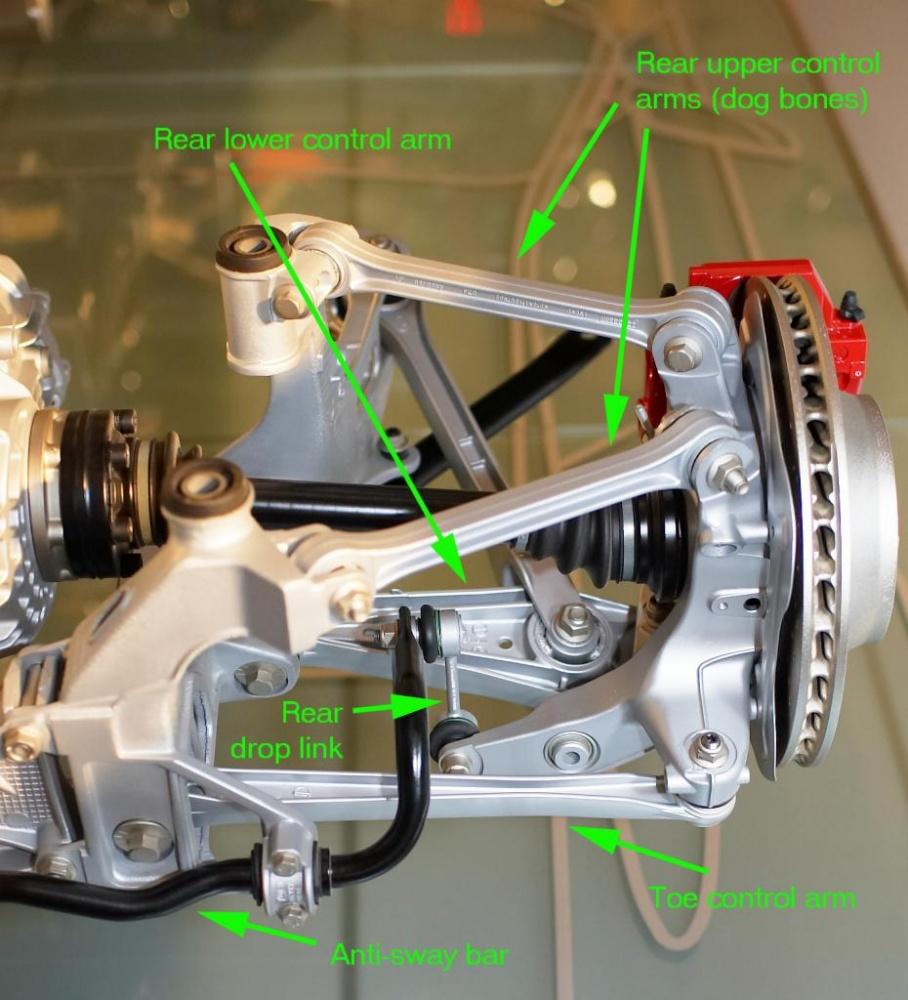
Data from Wheels Enhancement below. I remember vaguely a weight saving over stock of something like 12 lbs all 4 wheels?
I think all the after-market forged one-piece wheels are within 1-2 lbs of each other once you add up all 4 wheels. I felt free to pick and choose according to look alone.
Porsche Factory 997 Turbo
8.5x19" 23 lbs. 14 oz.
11x19" 28 lbs. 13 oz.
HRE P40 Monoblok
8.5x19" 21 lbs. 8 oz.
11x19" 24 lbs. 14 oz.
HRE P43 Monoblok
8.5x19" 21 lbs. 8 oz.
11x19" 25 lbs.
